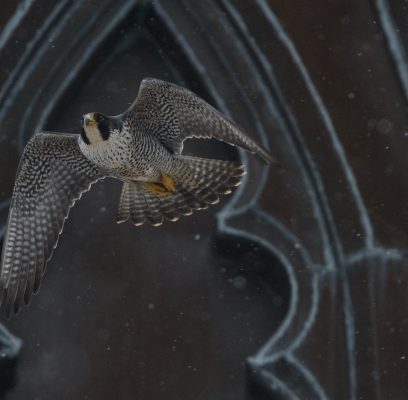After a rather brief snowy owl ‘season’ I have now turned my attention to another large raptor that intrigues me: the peregrine falcon.
Peregrines are the fastest member of the animal kingdom capable of reaching speeds of more than 300km/hr when they dive for their prey.
Two years ago I encountered one for the very first time, in a farmer’s field, plucking the feathers off a duck before devouring it. Peregrines are nicknamed ‘duck hawks’ for good reason! But they will go after smaller birds too.
Urban centres are popular havens for this raptor mainly because of the abundance of pigeons and other bird species that provide sustenance on a regular basis. I have been observing a pair of adult peregrines locally that have been here a year or two. It is only the last week or so that I have begun photographing them as they fly between several rooftops near the Grand River.

Like any species it takes a while to figure out their behaviour.
While bald eagles, snowy owls, ospreys, red tailed hawks and other raptors give clues right before they take flight – bobbing of the head, stretching their wings, pooping and generally looking agitated – these peregrines seem to be constantly ‘wired’.
This hyper-alert state may be useful for their hunting purposes but for a photographer it can pose problems. I mean, have some consideration, eh!
A few times I have missed them take flight as I lowered my camera to relax and in that instant they were airborne.
Last week I drove to one of the places I’ve seen them regularly, parked my car and got out only to see one flying away. It was the female. Instinctively, I thought I would have a long wait for her to return so I took my eye off her. Bald eagles will be gone for ages. Not so this peregrine. Two minutes later she came back with a pigeon in her talons.

After landing on a stone column she started plucking feathers. Clearly, she was also battling a very strong wind. That resulted in her taking shelter around the corner of the building. I watched her eat while her mate screeched at her from a couple of metres away. Apparently she doesn’t like to share.
Finally, after being fully satiated, she went off with the remains storing them elsewhere on the roof of this building.

A couple of days later I saw both dining on smaller birds. And for the third time in a week I saw them mating.

Peregrines mate for life. This male has been banded which indicates he has been captured and released either for rehabilitation purposes or for research. You can see a metal band on his right leg and a plastic one on his left. I have not been able to capture images with a clear view of the metal one but I will keep trying. Together the bands would give the US Geological Survey the identity of this peregrine and his background.

They are remarkable to watch and each encounter I have with them teaches me more about their behaviour. Time will tell if they are able to produce chicks later in the spring. Isn’t it wonderful to have such neighbours?
——————————————————————————————————————————————–


Love these birds. Incredible pictures
Thank you Darryl! Incredible to see them in action.
Wonderful stories and storytelling. Thank you!!!!!
Pleased that you enjoyed this blog, Jaellayna. Thanks for your note!
Amazing photos, Paul.
I had finished reading Adam’s Shoalt’s most recent ‘Odyssey’ book on his gruelling padddling and trekking travels to follow the migration of Peregrines from Long Point Ontario to the Torngat Mountains in Northern Labrador.
He might like to see your photos of this pair of mates?
Wonder if they will head North or stay put and fledge here?
thanks Carol. I am also a fan of Adam Shoalts’ books. I think I have all of them. A modern day adventurer for sure!
Thanks Paul. Great shots and accompanying text to tell the story.
Glad you liked this blog, Dave! Cheers!
Wow, That is some spectacular photography. I didn’t know they were urban dwellers. Keep it up, sir. We enjoy every post.
Thank you Jeff! This pair seem to spend a lot of time chasing pigeons along the Grand River not far from your abode! Hope to see you soon!
Fantastic photos – congratulations – will continue to follow your presentations, Denise
Hi Denise, thanks for your kind words. Sorry about the ‘awaiting moderation’ but I think it means that, since you are new to commenting, your post must wait for me to approve. I don’t always check the website regularly. Would you like me to add you to my mailing list?
What is meant by ‘awaiting moderation’
I love that you have met “my” pair of falcons and are also watching out for them!
Now that I met you at your recent Arctic wildlife talk at the library, I will keep an eye out for you when I visit my most beloved birds
Thanks for attending my Arctic presentation, Heather! It was very nice to meet you and share tales of the peregrines. Back in March the Waterloo Region Record ran one of my peregrine photos on the front page. They are exciting to watch and have escaped the attention of most people who walk beneath them without looking up! Every time I drive past their most popular spots I slow down to look for them.